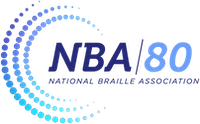Julie Sumwalt
Forum Replies Created
-
AuthorPosts
-
Julie Sumwalt
ParticipantHi Greta,
Right, the capital indicator after Quick cancels its standing alone status and signifies the start of a new word. "QuickPay" is two unspaced words. "Quickpay" is one word and according to UEB 10.9.3c the shortform could be used.
Braille on,
Julie
Julie Sumwalt
ParticipantHello,
Glad you asked! Each symbols-sequence needs to be italicized separately. The numeric space indicator is only used for numeric segments of a single number. It isn't meant to keep symbols-sequences together in general. It would not be appropriate here because the letters GMT do not represent numbers.
Braille on,
Julie
Julie Sumwalt
ParticipantHi Greta,
You got it! That's exactly right.
Braille on,
Julie
Julie Sumwalt
ParticipantI apologize for the delay in responding. Your files came through in ASCII. What I need are the BRF files so I can see the braille you've done. I also need the print files so I can see your source.
Thanks,
Julie
Julie Sumwalt
ParticipantHi,
Have you been able to manage smaller files? I really can't answer your question without seeing the print.
Regards,
Julie
Julie Sumwalt
ParticipantHi Rebecca,
No, the alphabetic wordsign would render this as the capitalized word "as," completely altering the meaning. Braille this exactly as you see it: .As.
Braille on,
Julie
-
This reply was modified 8 years, 8 months ago by
Julie Sumwalt.
January 23, 2017 at 2:37 pm in reply to: Rule 8.6.2 In the Rules of Unified English Braille Second Edition 2013 #28207Julie Sumwalt
ParticipantRule 8.6.2 does indeed say that “The capitals terminator may precede or follow punctuation and other terminators but it is best that indicators and paired characters such as parentheses, square brackets and quotes be nested. That is, close punctuation and indicators in reverse order of opening.” Either way is acceptable. Since you are asking about the NLS/NFB Lesson Manual, however, I suggest you take this up with NFB. You can contact them at transcribers@nfb.org.
Braille on,
Julie
Julie Sumwalt
ParticipantThanks! That makes sense. It did seem so awkward to treat it as a passage.
Julie
Julie Sumwalt
ParticipantHP LaserJet 5200tn
Julie
Julie Sumwalt
ParticipantThe photocopier that our office uses is the Ricoh MP 3500.
Julie Sumwalt
ParticipantAh! Good tip. Thanks, I'll try that.
Julie Sumwalt
ParticipantJulie, if you slow down the speed of the mouse (or in this case the "pen") you will be much more successful. I know that this is also true when you use a Bamboo tablet with Apple computer.
Good luck!
BettyJulie Sumwalt
ParticipantThere are lots of trainings going on around the country through different organizations. The BANA website has tried to keep an ongoing list of people who are doing training...some will accept outside attendees and some will not.
The NBA 'Bulletin' will begin posting articles and examples in both EBAE and UEB very soon...that would be a good introduction. The BANA website has many resources for becoming familiar with UEB...the 'ABC's of UEB' is a fairly recent addition that looks at the differences between EBAE and UEB.
CNIB has a free online course that is fairly basic and can be ordered from their website. It is geared toward those who already know braille and just want to learn UEB. You can also take a free certification test at the completion of that course. Whether the agency you do work for will accept the Canadian certification will be up to them.
Australia also recently posted an online resource for learning UEB. It's really aimed at people who don't already know braille, but it IS a good resource for learning UEB as well. You can find that one at http://uebonline.org/login/.
Of course, there are definite benefits for going to something 'live', but we understand that many do not have that option. It is highly likely that NBA will focus on basic UEB training for the next couple conferences...if it would be possible to attend one other than the one in Milwaukee, I would very much encourage you to try. The next two will be in Austin, TX and Louisville, KY.
Cindi Laurent
Julie Sumwalt
ParticipantJulie, Thank you for the response. So far that has been our solution, too. If we manage to resolve the issue I will be sure to post it here so it may be of benefit to others.
Julie Sumwalt
ParticipantSounds complicated, doesn't it? An update was made to the code, either last year or the year before, about abbreviations consisting of unspaced numbers and letters. They are capitalized and punctuated mathematically. This change does not apply to abbreviations made up entirely of letters.
-
This reply was modified 8 years, 8 months ago by
-
AuthorPosts
